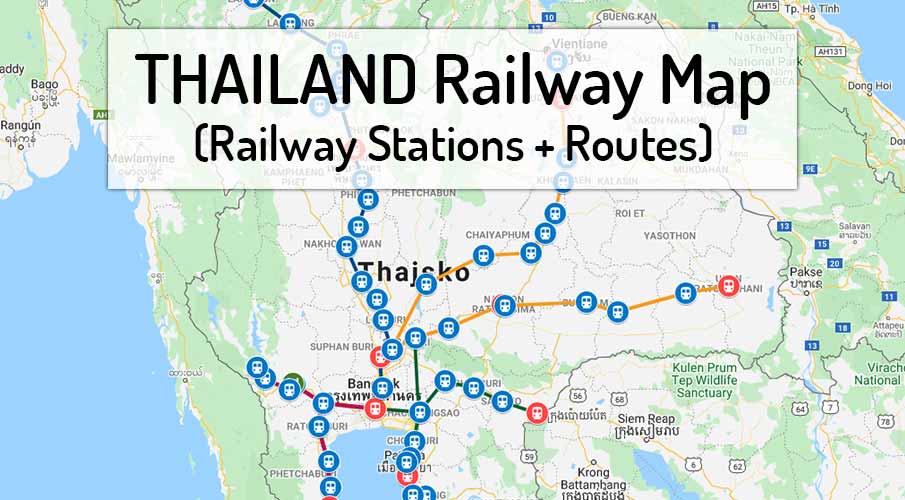
🚆 Railway in Thailand
📍 Thailand Train Map
🚉 Railway Routes
❓ FAQ + Travel Tips
🎫 Book Train Ticket
Quick answer: The rail map for Thailand shows the main lines and stations across the country, including the Northern, Northeastern, Eastern and Southern corridors. It’s a useful tool if you’re planning to travel by train in Thailand. You can view or download the map of the Thai railway network.
At a glance:
- 📍 Main lines: Northern (Bangkok → Chiang Mai), Northeastern (Bangkok → Nong Khai / Ubon Ratchathani), Southern (Bangkok → Surat Thani / Hat Yai / Padang Besar), Eastern (Bangkok → Aranyaprathet / Pattaya).
- 🚆 Key stations: Bangkok (Hua Lamphong / Krung Thep Aphiwat), Ayutthaya, Lopburi, Chiang Mai, Nakhon Ratchasima, Ubon Ratchathani, Hat Yai.
- 🛤️ Network facts: Operated by the State Railway of Thailand (SRT). Although extensive, the network lacks high-speed lines for now.
- 💡 Tip: Look at the map before booking; popular routes fill fast and you might prefer a sleeper train for overnight trips. Online booking is available.
Last updated in November 2025
Thailand has a wide railway network, and also modern trains.
-
- Explore Thailand’s Extensive Train Network – While Thailand boasts a sprawling train network, there are still beloved destinations inaccessible by rail. Many places can only be reached by bus, car, or motorbike. However, key tourist spots typically have railway or train stations nearby. Bangkok serves as the central railway hub, being the capital and largest city of Thailand. The city also features an urban train line. Departing from Bangkok, travelers can journey via Thai Railways to various regions in the north, northeast, east, or south of Thailand. The country’s railway network comprises four main lines: the Northern, Northeastern, Eastern, and Southern Lines. Additionally, there are stations near the borders with Laos, Myanmar, and Malaysia, such as Nong Khai + Ubon Ratchathani (Laos border) or Aranyaprathet (Cambodia border).
There are 1st, 2nd and 3rd class seat or sleeper trains of Thai Railways.
-
- The State Railway of Thailand (SRT) (Thai: การรถไฟแห่งประเทศไทย) operates as the state-owned rail operator under the Ministry of Transport. Offering a blend of modern and traditional trains, SRT runs commuter rail services from Bangkok along the Northern and Northeastern Lines, serving destinations like Ayutthaya, Ban Phachi Junction, Lopburi, and Kaeng Khoi Junction. Plans for high-speed railways on select routes are also underway. Popular routes among tourists include Bangkok to Chiang Mai, Bangkok to Surat Thani, and Bangkok to Nong Khai. Online booking for train tickets in Thailand is available. Check out the Google railway map of Thailand below and explore additional transportation options in Thailand in this article: Transportation in Thailand.
📍 Thailand Railway Map:
Some small and not so important railway stations in Thailand are not marked in this Google map, becaues travelers do not use them. Red circle – the main and bigger railway stations. Click the red icon for the more information about train transport.
🚉 The most frequented railway routes in Thailand:
❓ Frequently Asked Questions – Trains in Thailand:
1. Are there trains in Thailand?
-
- Yes, there are various trains in Thailand, these trains are operated by The State Railway of Thailand (SRT). Thailand has 5 major railway lines in the whole country – Northern Line (trains to Chiang Mai), Northeastern Line (trains to Nong Khai), Eastern Line (trains to Ubon Ratchathani, Pattaya) and Southern Line (trains to Surat Thani, Sungai Kolok) and train from Bangkok to Kanchanburi.
2. How to book and buy train tickets for trains in Thailand?
3. What types and classes of trains travelers can use in Thailand?
-
- There are 3 classes of trains – 1st class trains, 2nd class trains, 3rd class trains. The best and comfortable trains for travelers is the 1st or 2nd class train. There are seats or sleeper berths in these trains. Types of trains in Thailand – Special Express, Diesel Railcar, Express, Rapid, Ordinary, Commuter, Local.
4. What is the major train station in Thailand?
-
- The major railway hub is Hua Lamphong Railway Station and Krung Thep Aphiwat Central Terminal Station in the city center of Bangkok. From these train stations you can travel to every of the 4 major lines in the country – north, east, northeast, southern line.
5. Is it possible to buy food and drink in the trains in Thailand?
-
- Yes, it is generally possible to buy food and drinks on trains in Thailand. However, the availability of food and drink services may vary depending on the class of travel and the specific train route. In higher classes such as 1st and 2nd class, there are often food and beverage services available onboard. These services may include a trolley service offering snacks, beverages, and sometimes even meals. In some cases, there might be a dining car where passengers can sit and enjoy a meal during their journey. In 3rd class, where the facilities are more basic, food and drink options may be more limited. Vendors may occasionally pass through the train selling snacks and drinks, but there might not be dedicated onboard catering services.
6. Is there a baggage limitation in the train?
-
- Each passenger is entitled to carry one large and one small piece of luggage, but this rule is not strictly enforced. No one will weigh or check your suitcases. In first class you are entitled to bring 60 kg per passenger, in second class it is 40 kg per passenger and in third class it is 30 kg per passenger.
7. Will the train in Thailand arrive on time?
-
- The punctuality of trains in Thailand can vary depending on several factors including the specific train route, the class of service, and external factors such as weather conditions and track maintenance. While efforts are made to adhere to schedules, delays can sometimes occur. Generally, long-distance trains tend to have a better track record for punctuality compared to shorter commuter services. Trains on popular tourist routes may also be more punctual to accommodate the needs of travelers. The network consists of multiple routes connecting major cities, towns, and tourist destinations.
8. Is there a train from Thailand to Cambodia and Laos?
-
- There are trains to the border with Cambodia and Laos. From Bangkok to Nong Khai (Laos), from Bangkok to Ubon Ratchathani (Laos), from Bangkok to Aranyaprathet (Cambodia). Sungai Kolok Railway Station in southern Thailand – travelers heading to Malaysia.
9. How many railway routes are in Thailand?
-
- There are 5 major railway routes in Thailand. It is possible that in the future this network would be expanded.
10. Is there a high-speed train and railway in Thailand?
-
- No, there is no high-speed train in Thailand, but in the future there should be build a new railway for these trains. E.g. high-speed railway between Bangkok > Nong Khai, Bangkok > Chiang Mai or Bangkok > Pattaya.
11. How to travel with children in thai trains?
-
- Children under the age of 3 with a height of less than 100 cm travel free of charge if they can share a seat with an adult. Children under the age of 13 with a height of less than 150 cm can get a discount, based on the type of the train, the class and the carriage. The discount is between 10 and 20 percent.
12. What is the transportation in Thailand?
-
- Travelers in Thailand can use various modern tourist buses or minivans, flights, trains, private cars / taxi and nearby islands are accessible by various speedboats / ferries. Read this article: Transportation in Thailand.





| Train Type in Thailand: | Description |
|---|---|
| Ordinary Train | The Ordinary Train is the traditional and slowest type of train in Thailand. It features wooden seats, open windows, and fans for ventilation. This type of train offers a basic travel experience, suitable for those who prefer a leisurely pace and enjoy the scenery along the way. It makes frequent stops at many stations along the route, making it convenient for passengers traveling to intermediate destinations. |
| Rapid Train | The Rapid Train provides a faster option compared to the Ordinary Train. It is equipped with better seats and basic air conditioning, offering a more comfortable journey for passengers. While still making stops at various stations, the Rapid Train maintains a relatively swift pace, making it suitable for travelers who prioritize speed and comfort without the premium fares associated with faster train types. |
| Express Train | The Express Train is a medium-speed train that offers an improved travel experience compared to the Rapid Train. It features upgraded seating, air conditioning, and often includes a dining car where passengers can enjoy meals during their journey. The Express Train is ideal for longer-distance travel, providing a convenient option for passengers seeking a balance between speed and comfort. It typically stops at major stations along the route, offering connectivity to key destinations. |
| Special Express Train | The Special Express Train is the fastest and most luxurious type of train in Thailand. It offers comfortable seating, air conditioning, dining car facilities, and sleeping compartments for overnight journeys. The Special Express Train provides a premium travel experience for passengers on long-distance routes, offering limited stops and faster travel times compared to other train types. It is an ideal choice for travelers seeking convenience, comfort, and speed for their journey. |
| Diesel Railcar Train | The Diesel Railcar Train is a modern type of train powered by diesel engines. It features air conditioning and offers faster transportation on shorter routes compared to traditional trains. The Diesel Railcar Train provides a comfortable and convenient option for regional travel, connecting smaller towns and cities efficiently. It is suitable for passengers seeking a hassle-free and efficient mode of transportation for their journey. |
